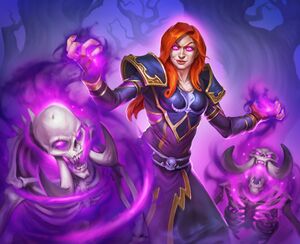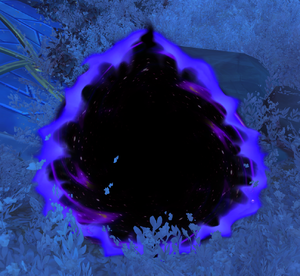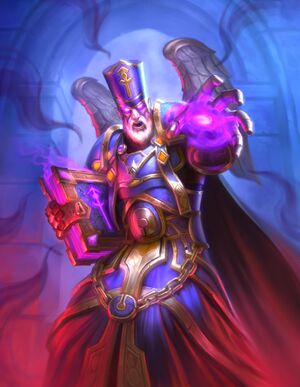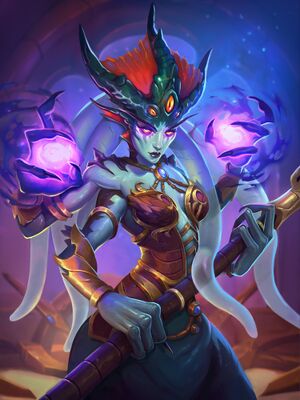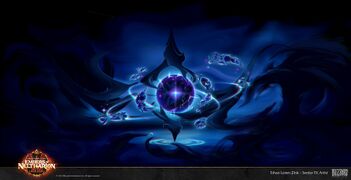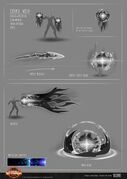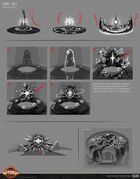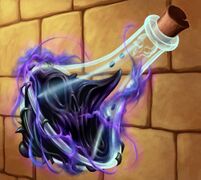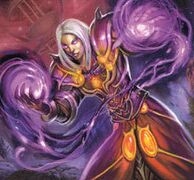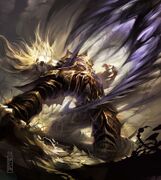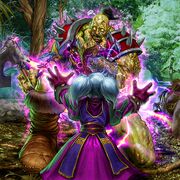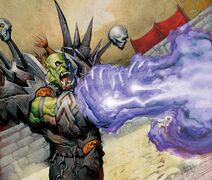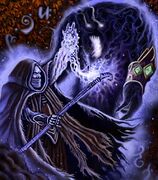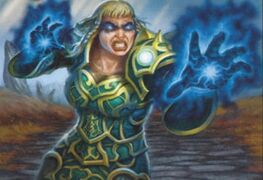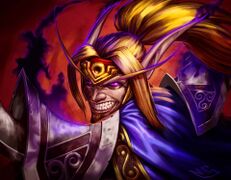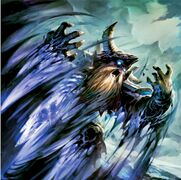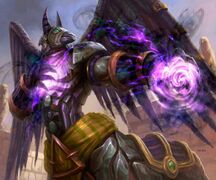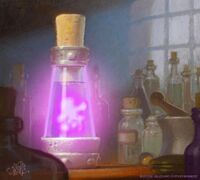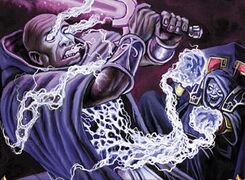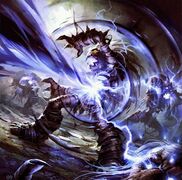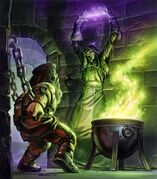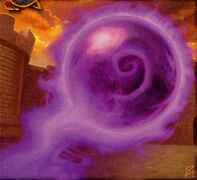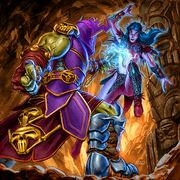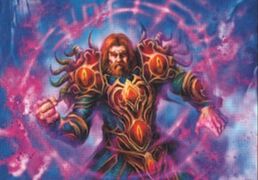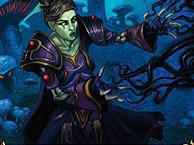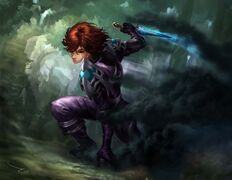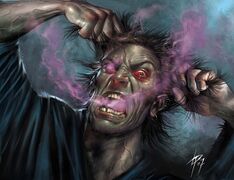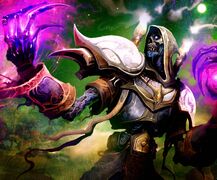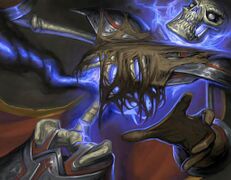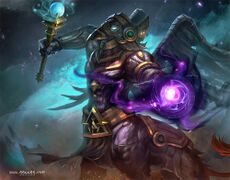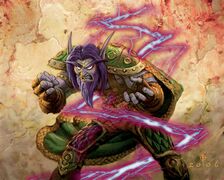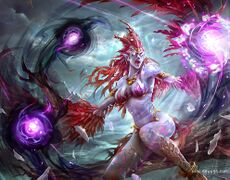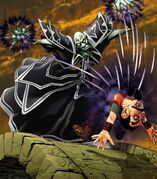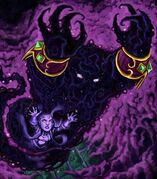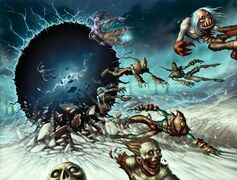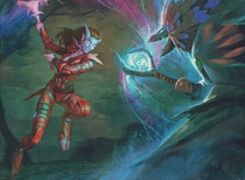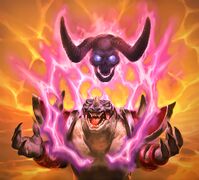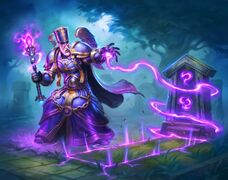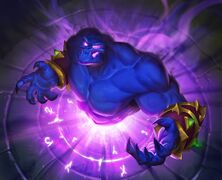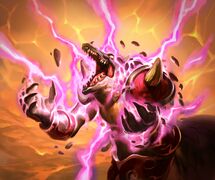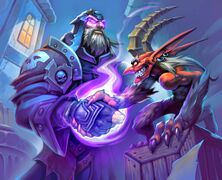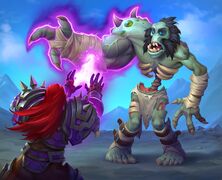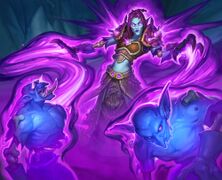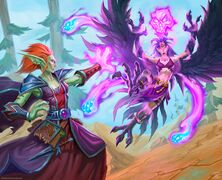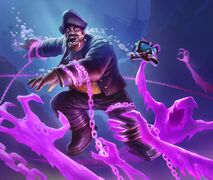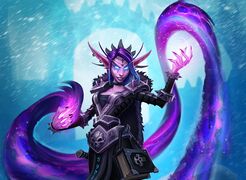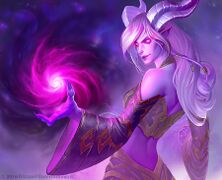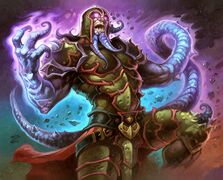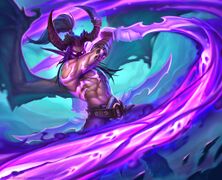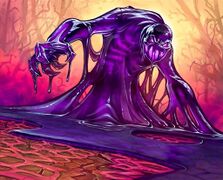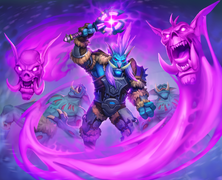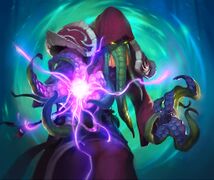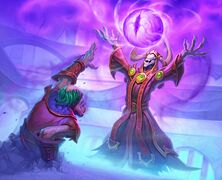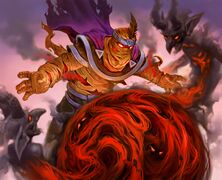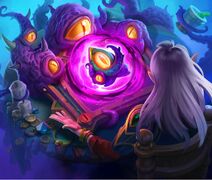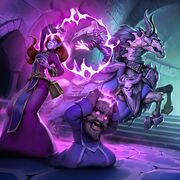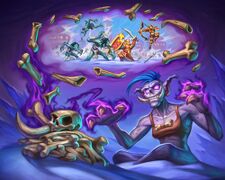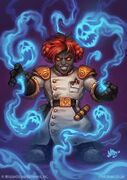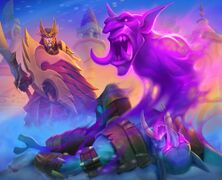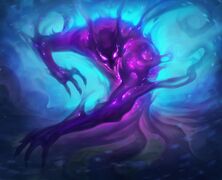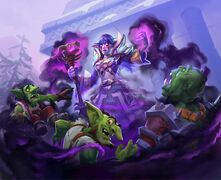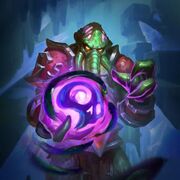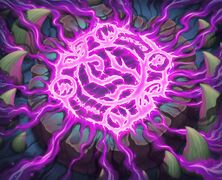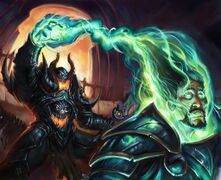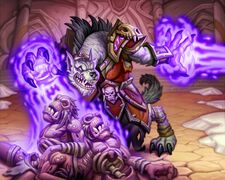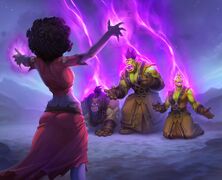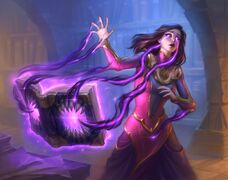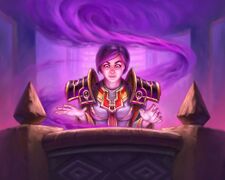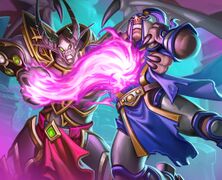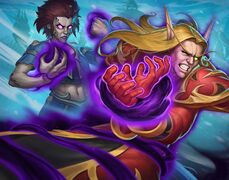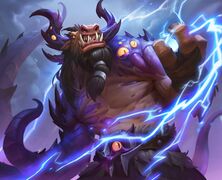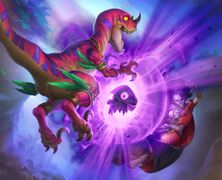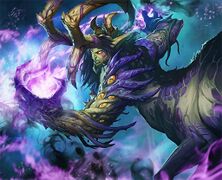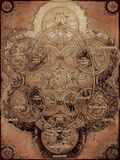Shadow (magic)
- For other uses, see Shadow (disambiguation).
“War is chaotic and savage. No matter what you witness--what you experience--you must never lose control. Do not let the shadows overtake your will.”
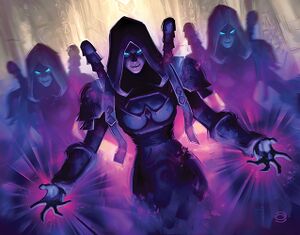
Shadow magic (or void)[2][3] magic[4][5] is the manifestation of the Void as it cannot exist in its pure state within the Great Dark Beyond. A source of terrible power, it is the kind of power that comes at a price,[6] as the very nature of the Void is hostile to what the mortal know as life and sanity,[7] and will do whatever it takes to drive them to madness. Shadow abilities are able to impart feelings like despair, doubt, and panic.[8] Nevertheless, the Void itself is not necessarily "evil"; it is a primal force with its morality characterized by how it is wielded.[9]
Origins and characteristics
Since pure Void cannot exist within the physical universe, shades of it manifest as shadow magic.[10][11] According to Lothraxion, when the Void is invited into a heart, it ends in madness. Wielding its power creates a hunger for more power, which can be a trap. Once someone starts using the shadow, they will belong to the Shadow.[12] When Alleria reached out for the Void, dark power flowed into her and she could feel the maddening whispers flooding her thoughts,[13] giddy and raving.[14] Wielders of this power can also receive terrible visions from the Void,[15] including visions of the future which can seem true but are actually strong and intoxicating lies that lead to madness,[16] as the Void cannot fully see destiny, and will do everything it can to shatter the will and sanity of its wielders,[17] using their fears and loves to achieve its goals.[18] The voices say many things, from lies, to things that are true from a certain point of view, things that sound true, and things that one would wish were true.[19]
Uses and powers
![]() Please add any available information to this section.
Please add any available information to this section.
Shadow abilities are able to impart feelings like despair, doubt, and panic, while the Light is often said to bring about feelings of a positive emotion such as hope, courage, comfort and the like. In a poetic sense, it can be said that the emotions which the Light brings about come from the "heart", whereas the emotions manipulated by shadow are often based on survival logic, and therefore affect the "mind".[20] Shadow priests preach balance between Light and Darkness, for it is often too hard to find one's way back to the Shadow from the deepest reaches of the Void.[21]
Shadow magic can be used to damage, drain, curse,[22] corrupt, silence, fear, and weaponize the enemies' minds, notably by harnessing the shadows into bolts of incendiary energy, or through the Shadow Words. It can be used to become invincible, protect oneself, empower weapons, remove diseases, teleport behind someone, and to weaken and see through a target's eyes. It can also deliver great amounts of immediate damage, or wracking pains that punish foes over longer periods of time.[23] Drawing on their dark powers causes Shadow priests to accumulate Insanity, which they use to fuel their potent spells of psychic agony. They can assume the Shadowform and the Voidform - distinctive auras that increase their powers. They can even call down beings from the Void itself, conjuring shadowfiends or mindbenders to assail their enemies.
Wherever there is light, there is shadow, and it is this shadow that the orc necrolyte uses to see into places he cannot travel with a spell called "Dark Vision". Wherever the slightest shadow is cast, their sigh can enter and view. The effects of this spell are limited in size, for too much knowledge of the confines of shadow has been known to forever trap the caster within the realm of darkness.[24]
Through the shadows, healing can be sacrificed to deal damage,[25] and damage can be convert into healing. The Void can also be used to resurrect the dead or in the case of necromancy.[26][27] The void can be used to create portals of teleportation.[28] Void elves can use their powers to create a Spatial Rift and instantly teleport on a short distance.
Despite the risks, many have sought to harness this corruptive magic, and those who tried have fallen into madness. Determined to use this power for the good of Azeroth, Alleria Windrunner was the first mortal to succeed at defying the shadow's whispers, after being trained by the mysterious Locus-Walker. Coming to the aid of a group of her kin who nearly gave in to the darkness, Alleria trained these void elves to control the shadows within them,[29] to keep control and fight the voices in their mind. This assault is relentless and the discipline needed to resist them is extraordinary.[30]
Some priests also pride themselves on pragmatism. They understand that light casts a shadow, that darkness is defined by light, and that true discipline stems from one’s ability to balance these opposing powers in services of a greater cause. While these priests possess many holy virtues, they dabble in the dark arts to debilitate their enemies—always exercising immense discipline to keep themselves away from the brink of insanity.[31]
Effects on beings
The Void can consume life or meld with it, but the latter often has unperceived consequences.[32] Rumor has it that some beasts that were touched by the Void exist in a space between this world and the next.[33] When a soul is consumed by the Void, an echo of the soul is all that is left behind. Neither in the physical or spiritual sense of the word would these echoes be considered alive. The echo is merely a twisted reverberation of the anguish left behind by the soul as it is consumed. These twisted echoes of the dead are merely the distorted reflections of once noble spirits.[34]
The undead are beings who have died and become trapped between life and death. One of the consequences of the involvement of Void in the undead's metaphysics is that they only feel faint sensations of pain or discomfort from most physical stimuli. This is also why the Light is so painful to their existence. The dark energy serves as a buffer that prevents the souls of the undead from properly joining their bodies. As a result, their souls are imperfectly attached to them.[35]
Practitioners
The most common practitioners of shadow magic are called shadowcasters[36] and shadowmages.
Shadow priests
The shadow priests fully embrace the opposing polarity between the Light and the Void, their faith equally resolute as their holy counterparts—but focused on shadowy magics and mental manipulation. Like all priests, they dedicate much of their lives to worship—but they derive their power from the Void, straying dangerously close to the domain of the Old Gods. To truly understand such ancient, corruptive influence is to be driven mad. This is the state in which these dark priests thrive, embracing insanity and feeding off of the minds of their opponents to reach terrifying new limits.[31]
Rogues
The Subtlety rogues are the masters of the shadows. They don't have the lethal poison-tipped daggers of the assassin or the brawling prowess of the outlaw, but their acumen on the battlefield and ability to hide in plain sight are unrivaled. Some claim the art of subtlety looks like malevolent shadow magic—but no matter from where their power is derived, they are capable of performing devastating assaults on their enemies, slipping away unharmed to strike again without detection. Most rogues train their entire lives to learn how to walk in the shadows—subtlety rogues were born there.[37]
Necrolytes
The necrolytes are a type of necromancer who use the dark energies of the Void, they are binders of souls and command the black powers that hold control over the earth.[21]
Warlocks
The warlocks are magical practitioners who seek to understand darker, fel-based magics, including destructive spells.[38] Warlocks peer into the Void without hesitation, leveraging the chaos they glimpse within to devastating ends in battle. Their greatest abilities are fueled by the souls they've harvested from their victims and they exploit powerful shadow magic to manipulate and degrade the minds and bodies of their enemies. They harvest the souls of their defeated enemies; those specialized in the ways of demonology use this life essence to tap into the Void, pulling all manner of abominations from the chaos of the Twisting Nether. Affliction warlocks are masters of shadow-touched powers, but unlike shadow priests—deadliest when pushed to the brink of insanity—these warlocks delight in using fel forces to cause intense pain and suffering in others.[39]
Dark shaman
While the shaman are spiritual guides and practitioners of the very elements, one way to become a dark shaman is to use the Void,[6] as shadow magic is capable of dominating and enslaving them.[40]
On Draenor, a group of dark shaman of the Warsong clan channeled Void energies near Oshu'gun in Nagrand, using the elements to channel the darkness of the void.[6] The dark shaman also used Nether Beacons, powered from within the Twisting Nether itself, to connect to the void,[41] and hidden behind the veil of the Twisting Nether, the abominations of the void began marching upon Oshu'gun.[42]
Arakkoa
The Arakkoa Outcasts are a collection of broken and flightless arakkoa who revere Anzu, and use shadow magic similar to that of Azerothian shadow priests.[43] Among them, the Talonpriests are followers of Terokk that wield dark powers of the Void.[43] They use special elixirs to cross over into a realm of shadows, which is also where they sealed Terokk after he descended into madness.
Ages ago on Draenor, the ancient Apexis, guided by tales of their god Anzu and his noble sacrifice, investigated the Sethekk Hollow. By carefully studying the cursed pools, they unraveled the mysteries of shadow magic and developed the unique ability to combine the arcane with the Void. Embracing both Light and Void, the Apexis believed they were both natural parts of life. Two factions formed within the Apexis: the Anhar order studied holy magic, while the Skalax studied shadow and arcane magics. Both groups occupied the upper echelons of arakkoa society, sharing equal prestige and influence.[44]
Darkfallen
The vampiric Darkfallen of the San'layn are known for their guile and dark magic, particularly the manipulation of blood and shadow magic.[45]
Naga
Transformed into naga by the Old God N'Zoth at the end of the War of the Ancients, the naga were once Highborne night elves, members of Queen Azshara's court. During the Great Sundering, Azshara pledged her allegiance to the Old God in order to survive the torrents that would drown them all. Since this moment, the naga have served the interests of the Old Gods for over ten thousand years and are therefore capable of manipulating shadow magic.[46]
Nathrezim
The nathrezim, otherwise known as dreadlords, are cunning, manipulative, and masters of the arts of shadow magic,[47] for which they dedicated their existence to mastering it.[48]
Trolls
Zandalari trolls have an impressive mastery over the arcane and shadow, having achieved what many others have not as they are able to combine the two schools into one.[49][50]
Some loa worshiped by the trolls, such as Bethekk, Quetz'lun, and Shadra are seen giving their faithful control over shadow magic.[51][52][53][54]
The shadow hunters are masters of voodoo and shadow magic and were once the highest authority amongst trolls, walking the line of dark and light in the hope of saving the future of trollkind, doing whatever it takes to secure a future for their kin.[55]
Void elves
The blood elves imbued with the Void's energies have been transformed into void elves. Under the tutelage of Alleria Windrunner and her teacher, Locus-Walker, the two known mortals who were able to successfully defy the Void's whispers and truly resist its corruption while wielding its powers. These ren'dorei, the "Children of the Void" have established a base at Telogrus Rift, and much like Alleria herself, have re-pledged themselves to their original faction, the Alliance.[56] Although having the power of the Void at their command has its benefits, it also has its drawbacks. Void elves must constantly resist the whispers of the shadow that attempt to lure them into madness. The Void seeks to strip away the void elves of their flesh and their mortality so that they may become slaves to the shadow's all-consuming hunger.[57] Furthermore, so long as the void elves pulse with void energy, they also become a beacon for other creatures of the void. If they cannot corrupt the void elves, they will use them to corrupt other powerful sources, such as the Sunwell.[58]
Void ethereals
The Void ethereals are ethereals infused with the power of the Void. Their energies are dark purple or red. They also hear maddening whispers that sway them to do the will of the Void.[59] Nexus-stalkers are a partially Void-based form of ethereals created by the rogue Ethereum faction, and are considered by the Protectorate to be aberrations.[60] Though the Ethereum was initially dedicated to hunting down and taking revenge on Dimensius, their goal later changed to "becoming void." To that end, they constructed a proto-accelerator which was used to manipulate the abundance of Void energy at Manaforge Ultris, bonding it with their own energy to transform into nexus-stalkers.[61]
Alternate Shadowmoon clan
on Draenor, when the Iron Horde strong-armed the Shadowmoon clan into joining them, Ner'zhul broke one of their ancient laws forbidding the use of the power drawn from the 'Dark Star', and they became powerful wielders of the Void. They experimented on the souls and bones of the dead in their burial grounds. When Ner'zhul was slain by adventurers, the rest of the Void practitioners seemed to join Gul'dan in the Fel Horde. Later, members of the clan joined the Mag'har Clans and traveled to Azeroth where they became part of the Horde.
Notes
- Yogg-Saron's blood, the saronite, is Void-tainted mineral.[62]
- Magister Umbric gave Alliance champions a Void Shard to cast Bilgewater Frackers into the Void.[63]
- Using a Void Totem weakens the barrier between the mortal world and the Twisting Nether.[64]
- In the Magocracy of Dalaran, researching into banned fields of magic such as shadow magic is expressly forbidden by laws almost as old as the Kirin Tor itself.[65]
- Some shadow hunters, including Vol'jin, have used shadow spells in addition to their Warcraft III abilities.
- The undead and draenei characters have the passive racial ability named
 [Shadow Resistance], which grant them a 1% reduction to all Shadow damage taken.
[Shadow Resistance], which grant them a 1% reduction to all Shadow damage taken. - The quest
 [10-35 Daily] Flames of the Void involves putting out "Void Flames" created by the sha running rampant throughout the Temple of the Jade Serpent.
[10-35 Daily] Flames of the Void involves putting out "Void Flames" created by the sha running rampant throughout the Temple of the Jade Serpent. - The term used to describe the combination of fel and Void energies seems to be Shadowfel.[67] The void revenant known as Xhul'horac was infused with fel energy and became known as a "Shadowfel Amalgamation", and deals Shadowfel damage during the encounter with it.
In the RPG
The shadow energy (aka Shadow Plane) is not limited to a single plane; it is instead an integral part of every aspect of the universe, woven into every plane. Thus, spells that call upon this energy, such as shadow conjuration, draw upon local sources rather than reaching to another plane. Positive energy remains associated with the energies possessed by living beings, and negative energy with the motive forces of death and the undead. Magical weapons that have effects wielding this energy draw upon energy bound into their own material, freed by enchantment.[68] "Shadow" is a spell type common to many items and spells created by the Shadow Council and other such nefarious organizations.[69] The arcane and shadow magic appear to be tied together.[70] Shadow appears to be split into subcategories or is synonymous with "Darkness", "Negative", "Death", "Destruction", "Chaotic", "Evil", and "Fel". It is a damage type often found as a bonus type damage (enchantment or enhancement). In one example it's also a sub-school of the magic school of Illusion (illusions composed of a quasi-real, tangible shadow material with shadow bonuses, ex. Storm, Earth and Fire).[71] Spells of shadow may derive their power from actual shadows & darkness.[72]
Shadow ascendants, followers of the Cult of the Forgotten Shadow, become one with this power as their physical form fades away. Some trolls revere these creatures as dark Loa.[73]
Gallery
- "Cosmic Void" Art
Patch 10.1 concept art of Void magic.
See also
References
- ^ Alleria's gossip on the Wind's Redemption
- ^ Matt Burns on Twitter
- ^ Matt Burns on Twitter
- ^ a b
 [Ur's Treatise on Shadow Magic]
[Ur's Treatise on Shadow Magic]
- ^

 [45] Safekeeping
[45] Safekeeping
- ^ a b c
 [35-40] Disrupt the Rituals
[35-40] Disrupt the Rituals
- ^ A Thousand Years of War, Part Three – Shadow & Light, pg. 36
- ^ Ask CDev#Ask CDev Answers - Round 3
- ^ Blizzblizz - Entrevista com Interview, 27:43
- ^ World of Warcraft: Chronicle Volume 1, pg. 10
- ^

 [45] Safekeeping
[45] Safekeeping
- ^ A Thousand Years of War, Part One – Two Bright Lights, pg. 19
- ^ A Thousand Years of War, Part Two – The Emerald Star, pg. 28
- ^ A Thousand Years of War, Part Three – Shadow & Light, pg. 33
- ^

 [10-45] Whispers in the Void
[10-45] Whispers in the Void
- ^ A Thousand Years of War, Part Three – Shadow & Light, pg. 36-37
- ^ A Thousand Years of War, Part Three – Shadow & Light, pg. 34
- ^ A Thousand Years of War, Part Three – Shadow & Light, pg. 38
- ^ Steve Danuser on Twitter: "With Void stuff, I picture it like a chorus of voices all saying 1000 things at once, many of which either are true (from a certain PoV) or sound true or that you secretly wish were true. Playing on every doubt and desire. It's not the lies that test you, but the near truths."
- ^ Ask CDev#Ask CDev Answers - Round 3
- ^ a b World of Warcraft: The Magazine Issue 4
- ^ World of Warcraft: Classic class description
- ^ World of Warcraft > Game Guide > Classes > Priest
- ^ Warcraft: Orcs & Humans manual
- ^ Character creation screen – Priest
- ^ World of Warcraft: Chronicle Volume 3, pg. 199
- ^ Shadowmoon Burial Grounds - Ner'zhul - Adventure Guide
- ^ Shadows Rising, chapter 9
- ^ Battle for Azeroth features - Allied races
- ^ Steve Danuser on Twitter: "This video picks up a point a lot of readers missed. While we only show the Void whispers in a few specific panels, that is what Alleria hears in her head. All. The. Time. The void elves face a similar relentless assault. The discipline needed to resist them is extraordinary."
- ^ a b Legion Class Preview Series: Priest
- ^ Voidstalker Runt
- ^
 [Lost Netherpup]
[Lost Netherpup]
- ^
 [35-40] Echoes of the Past
[35-40] Echoes of the Past
- ^ Blizzard lore posts
- ^
 [23G] Shadow Magic
[23G] Shadow Magic
- ^ Legion Class Preview Series: Rogue
- ^ Ultimate Visual Guide, pg. 21
- ^ Legion Class Preview Series: Warlock
- ^
 [35-40] Dark Binding
[35-40] Dark Binding
- ^
 [35-40] Through the Nether
[35-40] Through the Nether
- ^
 [35-40] The Void March
[35-40] The Void March
- ^ a b Don Adams on Twitter: "Correct!"
- ^ World of Warcraft: Chronicle Volume 2, pg. 24 - 25
- ^
 [60] Magus Installation
[60] Magus Installation
- ^ Warbringers: Azshara
- ^ World of Warcraft: Chronicle Volume 1, pg. 38-39 on e-book
- ^ World of Warcraft: Chronicle Volume 1, pg. 21
- ^
 [35 Daily] Knowledge Is Power
[35 Daily] Knowledge Is Power
- ^
 [35 Daily] Keep It Secret
[35 Daily] Keep It Secret
- ^ High Priestess Kilnara
- ^ Lesser Priest of Bethekk
- ^ Yazma (tactics)
- ^ High Priestess Tua-Tua
- ^ Vol'jin: Shadows of the Horde, pg. 226, 254 - 258
- ^
 [40-70] Telogrus Rift
[40-70] Telogrus Rift
- ^
 [40-70] Telogrus Rift
[40-70] Telogrus Rift
- ^
 [40-70] Remember the Sunwell
[40-70] Remember the Sunwell
- ^ General Zah'd
- ^
 [25-30] S-A-B-O-T-A-G-E
[25-30] S-A-B-O-T-A-G-E
- ^
 [25-30] Potential for Brain Damage = High
[25-30] Potential for Brain Damage = High
- ^ World of Warcraft: The Dragonflight Codex, pg. 85
- ^
 [60] The Void Solution
[60] The Void Solution
- ^
 [Void Totem]
[Void Totem]
- ^ The Schools of Arcane Magic - Necromancy
- ^
 [45] The Folly of Levia Laurence
[45] The Folly of Levia Laurence
- ^ Dave Kosak on Twitter (2014-08-19). Archived from the original on 2021-03-03. “Likely it's fel magic infused with shadow, hence the name. Ugly stuff. Don't stand in it!”
- ^ Shadows & Light, pg. 132
- ^ Magic & Mayhem, pg. 158
- ^ More Magic and Mayhem, pg. 73
- ^ Magic & Mayhem, pg. 100-101, 157, 158
- ^ Dark Factions, pg. 32, 93
- ^ Horde Player's Guide, pg. 63 - 64
| |||||||||||||||||||

